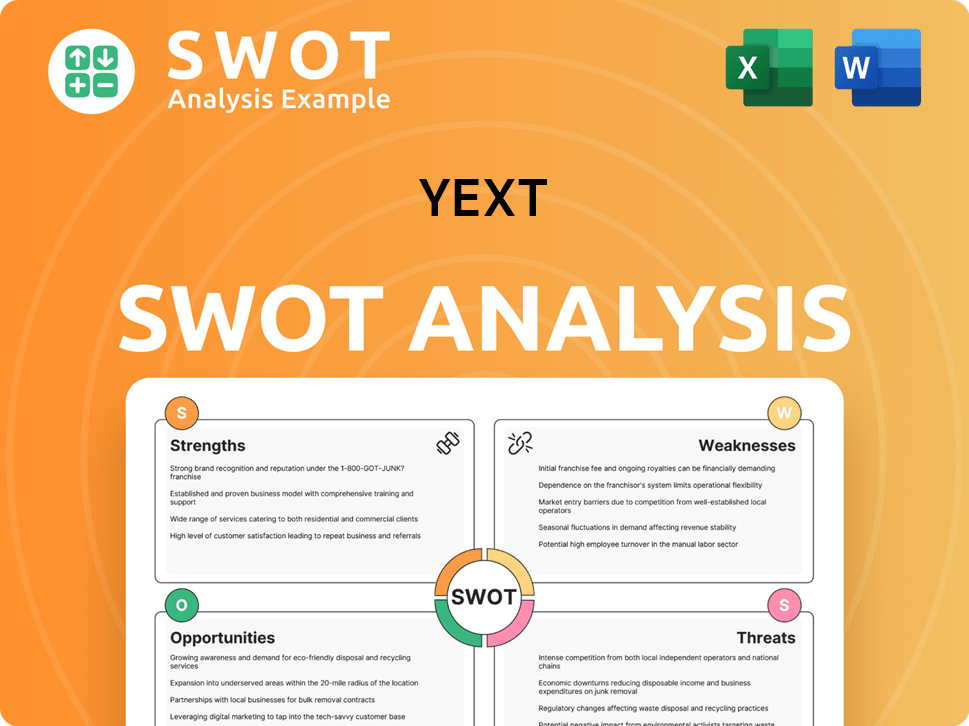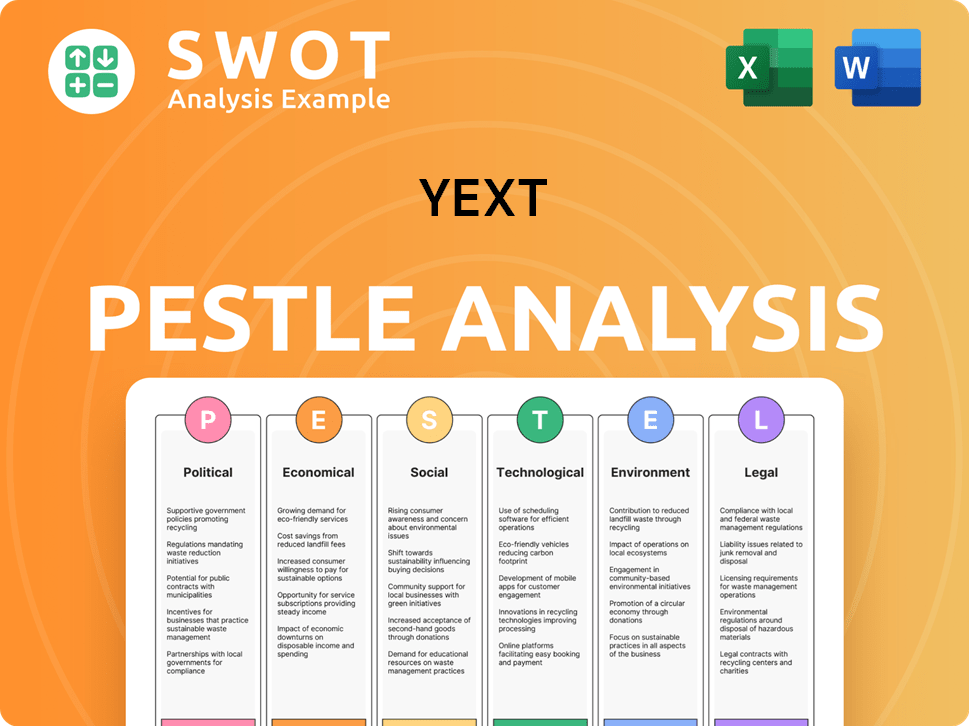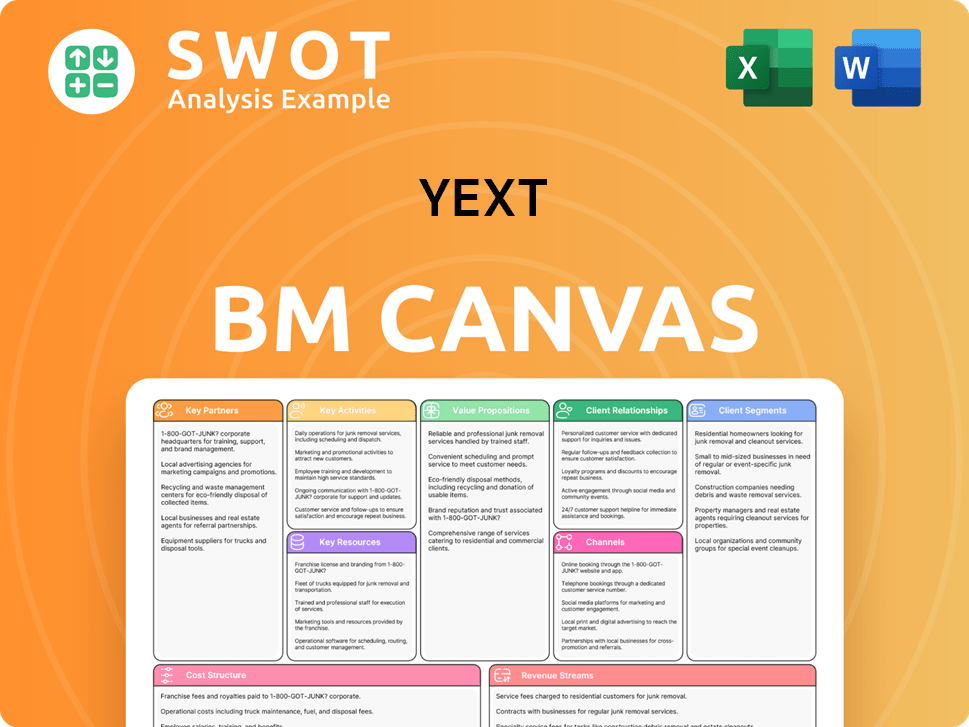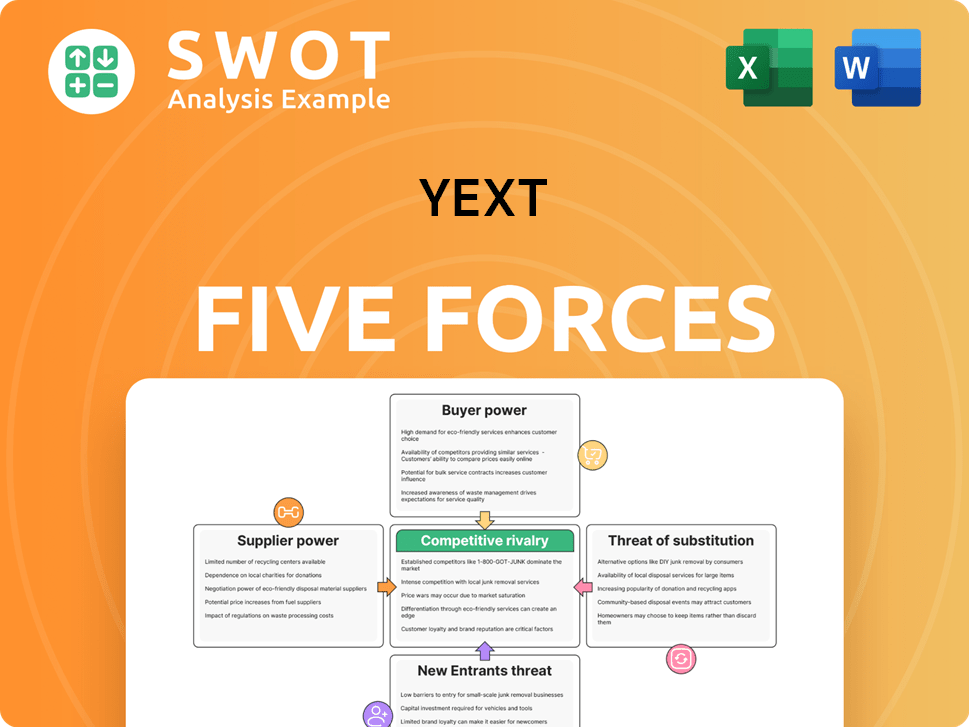Yext Bundle
Who Does Yext Serve in the Digital Age?
In today's fast-paced digital world, understanding Yext SWOT Analysis is crucial, especially with the rise of AI-driven search. Yext, a leader in digital presence management, needs to deeply understand its customer demographics and target market to thrive. This analysis explores Yext's customer profile, market positioning, and how it adapts to the evolving needs of its audience.

As search behaviors shift, with longer and more detailed queries becoming the norm, Yext's ability to understand its Yext target market is more important than ever. This comprehensive analysis will delve into the customer demographics of Yext, examining who its ideal customer is, and how the company strategically positions itself within the market. Understanding the Yext company analysis is key to grasping its potential for future growth.
Who Are Yext’s Main Customers?
Understanding the Revenue Streams & Business Model of Yext involves a deep dive into its customer base. The company, focusing on business-to-business (B2B) services, strategically targets various industries to enhance their digital presence and online reputation management. The Yext target market is diverse, encompassing sectors like healthcare, banking, retail, hospitality, and food services.
The Yext customer segmentation is primarily organized by the size of the organization, with a focus on small businesses, mid-market companies, and enterprise-level clients. This structure allows Yext to tailor its solutions to meet the specific needs and complexities of each segment. The company's approach ensures that its services are scalable and adaptable to different business requirements.
Enterprise-level clients are a significant part of Yext's direct customer base. Yext serves thousands of customers globally, including a substantial presence in the financial sector. This segment benefits from sophisticated solutions designed to manage numerous locations and complex data sets across various platforms. For example, direct customer Annual Recurring Revenue (ARR) grew by 19% to $371.8 million in Q1 2025, highlighting the value Yext provides to large enterprise clients, particularly in financial services and retail.
Yext has expanded its target segments through strategic acquisitions. The acquisition of Hearsay Systems in August 2024 broadened Yext's reach into financial services.
The Hearsay Systems acquisition added over 260,000 advisors and agents to Yext's platform. This move enabled Yext to provide compliance-driven engagement solutions.
The Yext customer profile emphasizes a focus on businesses that require robust digital presence management. The company's solutions are designed to meet the evolving digital engagement needs of larger, regulated businesses.
- Enterprise Clients: Large organizations needing comprehensive digital presence management.
- Financial Services: A key sector leveraging Yext for compliance-driven solutions.
- Retail and Hospitality: Industries benefiting from location data management and online reputation.
- Small to Mid-Market Businesses: Seeking scalable solutions for their digital needs.
Yext SWOT Analysis
- Complete SWOT Breakdown
- Fully Customizable
- Editable in Excel & Word
- Professional Formatting
- Investor-Ready Format

What Do Yext’s Customers Want?
Understanding the customer needs and preferences is crucial for a thorough Yext company analysis. Yext's customer demographics primarily consist of businesses seeking to enhance their online presence and manage their digital knowledge effectively. These businesses aim to improve brand visibility, boost customer engagement, and streamline information across various online platforms.
The target market for Yext includes businesses of all sizes, from small local enterprises to large multinational corporations, all sharing the need for centralized digital knowledge management. The Yext audience is driven by the desire to build trust and drive conversions by ensuring that potential customers receive accurate and positive information about their businesses across the digital landscape. This focus on accuracy and consistency is a key psychological driver for choosing Yext's offerings.
Purchasing behaviors indicate a preference for comprehensive platforms that consolidate various digital marketing functions. Customers are increasingly recognizing the value of a unified platform for managing social media, listings, and reputation data. Decision-making criteria are influenced by the platform's ability to provide actionable cross-channel insights and automate workflows at scale, enabling data-driven decisions.
Customers need to manage digital knowledge and online presence effectively. This includes ensuring consistent brand information across various online services, improving brand visibility, and enhancing customer engagement.
Customers prefer comprehensive platforms that consolidate digital marketing functions. This includes managing social media, listings, and reputation data within a unified platform.
Customers are influenced by a platform's ability to provide actionable insights and automate workflows. This enables data-driven decisions and improves overall efficiency.
Common pain points include the challenge of managing online reputation and maintaining consistent information across numerous directories. These issues are addressed by Yext's features.
Yext addresses these pain points with features like AI Review Generation and acquisitions like Places Scout. These solutions enhance visibility and improve competitive intelligence.
Yext tailors its marketing by emphasizing localization and the ability to create posts at scale. This ensures that content is relevant across thousands of locations without being generic.
Yext's ideal customer profile includes businesses that prioritize a strong online presence and efficient digital knowledge management. These businesses often seek to improve their search visibility, manage online reviews, and ensure consistent brand information across various platforms. The company's focus on localization and scalable content creation further supports its customer acquisition strategy, allowing businesses to reach their target audience effectively. For example, the AI Review Generation feature, launched in October 2024, simplifies and scales reputation management across over 80 platforms, including Google and Facebook. Further insights into the company's growth strategy can be found in this article: Growth Strategy of Yext.
Yext's core customers need solutions to manage their digital knowledge and online presence effectively. This includes improving brand visibility, enhancing customer engagement, and streamlining information management.
- Brand Visibility: Ensuring business information is accurate and consistent across search engines, maps, and apps.
- Customer Engagement: Facilitating interactions and managing online reviews to build trust and drive conversions.
- Information Management: Centralizing and updating business information across various online platforms.
- Competitive Intelligence: Gaining insights into competitors' online strategies through acquisitions like Places Scout.
Yext PESTLE Analysis
- Covers All 6 PESTLE Categories
- No Research Needed – Save Hours of Work
- Built by Experts, Trusted by Consultants
- Instant Download, Ready to Use
- 100% Editable, Fully Customizable

Where does Yext operate?
The geographical market presence of the company is primarily concentrated in North America and Europe. The United States is a significant revenue driver, contributing a substantial portion of the company's total revenue. The company's strategy involves expanding its customer base both domestically and internationally through targeted go-to-market initiatives.
The United Kingdom is also a key market, representing a significant portion of international revenue. The company serves thousands of customers globally, indicating a broad reach across various regions. The company focuses on expanding existing customer relationships geographically, encouraging growth within specific regions.
The company's expansion strategy includes acquisitions and strategic moves to strengthen its presence in diverse markets. The acquisition of Hearsay Systems in August 2024, a leader in digital client engagement, further solidified its presence, particularly in the financial services sector. This demonstrates its commitment to adapting to the unique needs of different regions and industries.
The United States accounts for a significant portion of the company's revenue, representing approximately 81%. This highlights the importance of the North American market for the company's overall financial performance. Understanding the customer demographics in this region is crucial for strategic planning.
The United Kingdom is a key contributor to international revenue, accounting for 18% of the total. The company's focus on the European market demonstrates its commitment to global expansion. Analyzing the customer profile in Europe is essential for tailoring marketing strategies.
The company serves thousands of customers worldwide, showcasing its broad global reach. This wide customer base indicates the company's ability to cater to diverse needs across different regions. Understanding the customer base analysis is key to success.
The acquisition of Hearsay Systems in August 2024 expanded its presence in financial services, a sector with a strong international footprint. This strategic move supports the company's commitment to diverse markets. For further insights, explore the Brief History of Yext.
Yext Business Model Canvas
- Complete 9-Block Business Model Canvas
- Effortlessly Communicate Your Business Strategy
- Investor-Ready BMC Format
- 100% Editable and Customizable
- Clear and Structured Layout

How Does Yext Win & Keep Customers?
The company employs a multi-faceted approach to customer acquisition and retention. This strategy leverages both direct sales and third-party resellers. A key element of their acquisition strategy involves developing and marketing innovative capabilities, often through strategic acquisitions, to attract new customers and expand existing relationships. Understanding the Owners & Shareholders of Yext is crucial to understanding the company's strategic direction.
Retention strategies are deeply integrated into the product development and customer success initiatives. The focus is on delivering more value, as seen with products like Yext Scout and Yext Social. The company also emphasizes the role of customer data and insights in tailoring marketing and product features, aligning with their prediction for 2025 that brands leaning into data and customer-centric content strategies will succeed.
The company's dollar-based net retention rate for direct customers was 95% in Q1 2025, signaling strong customer satisfaction and sticky relationships. This indicates the effectiveness of their retention efforts. They aim for continued improvement in retention by executing their product roadmap and delivering more value to customers.
The company actively seeks to attract new customers by developing and marketing innovative capabilities. This includes strategic acquisitions, such as the purchase of Hearsay Systems in August 2024. The goal is to create a unified digital marketing platform.
Customer success professionals play a vital role in driving platform usage. They build relationships with customers and increase adoption of the platform. Comprehensive training programs support these efforts to ensure customers fully utilize the platform's capabilities.
Yext Scout, an AI search and competitive intelligence agent, is designed to fundamentally change how customers gather insights. This tool helps prioritize actions for better visibility, which is expected to drive higher retention and reduce churn rates. It's a key part of the company's retention strategy.
Yext Social, an AI-powered local social engagement platform, has been gaining traction since its launch in September 2024. It has already secured direct and reseller customers, demonstrating its role in driving new customer wins and enhancing existing relationships. Since launch, it has gained 19 direct customers and 30 reseller customers.
The company emphasizes the use of customer data and insights to tailor marketing efforts. This customer-centric approach aligns with the prediction that brands focusing on data and content strategies will succeed in 2025. This data-driven approach helps refine the company's Yext target market.
The company provides comprehensive training programs to support customer success professionals. These programs help them build relationships with customers and increase platform adoption. This ensures that customers fully utilize the platform's features and benefits.
The company's customer base spans various industries and company sizes. By targeting diverse sectors, the company broadens its Yext audience and mitigates risks. This strategy supports its overall growth and market penetration goals.
Strategic acquisitions are a key part of the company's customer acquisition strategy. The acquisition of Hearsay Systems in August 2024 is an example of how the company expands its offerings. These acquisitions enhance the customer journey.
Customer success professionals play a crucial role in driving platform usage. They foster strong customer relationships and promote platform adoption. Their efforts contribute to higher customer satisfaction and retention rates. They help to define Yext ideal customer profile.
The company's dollar-based net retention rate for direct customers was 95% in Q1 2025. This high rate indicates strong customer satisfaction and the success of the company's retention strategies. This is a key metric for evaluating the company's performance.
Yext Porter's Five Forces Analysis
- Covers All 5 Competitive Forces in Detail
- Structured for Consultants, Students, and Founders
- 100% Editable in Microsoft Word & Excel
- Instant Digital Download – Use Immediately
- Compatible with Mac & PC – Fully Unlocked

Related Blogs
- What are Mission Vision & Core Values of Yext Company?
- What is Competitive Landscape of Yext Company?
- What is Growth Strategy and Future Prospects of Yext Company?
- How Does Yext Company Work?
- What is Sales and Marketing Strategy of Yext Company?
- What is Brief History of Yext Company?
- Who Owns Yext Company?
Disclaimer
All information, articles, and product details provided on this website are for general informational and educational purposes only. We do not claim any ownership over, nor do we intend to infringe upon, any trademarks, copyrights, logos, brand names, or other intellectual property mentioned or depicted on this site. Such intellectual property remains the property of its respective owners, and any references here are made solely for identification or informational purposes, without implying any affiliation, endorsement, or partnership.
We make no representations or warranties, express or implied, regarding the accuracy, completeness, or suitability of any content or products presented. Nothing on this website should be construed as legal, tax, investment, financial, medical, or other professional advice. In addition, no part of this site—including articles or product references—constitutes a solicitation, recommendation, endorsement, advertisement, or offer to buy or sell any securities, franchises, or other financial instruments, particularly in jurisdictions where such activity would be unlawful.
All content is of a general nature and may not address the specific circumstances of any individual or entity. It is not a substitute for professional advice or services. Any actions you take based on the information provided here are strictly at your own risk. You accept full responsibility for any decisions or outcomes arising from your use of this website and agree to release us from any liability in connection with your use of, or reliance upon, the content or products found herein.